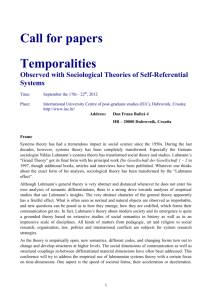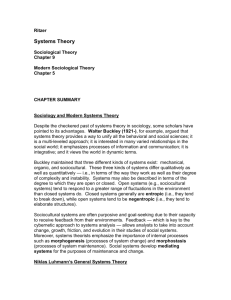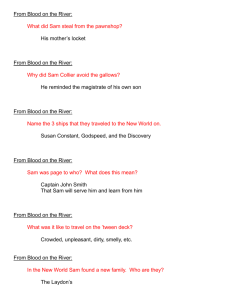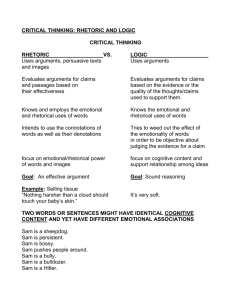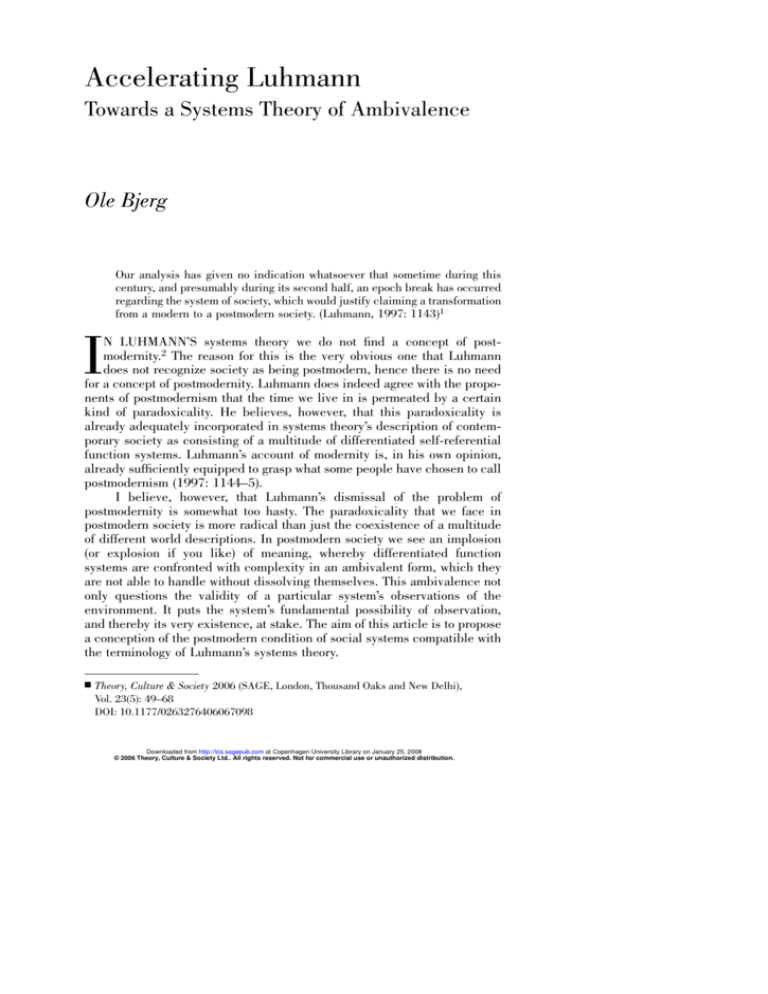
Accelerating Luhmann
Towards a Systems Theory of Ambivalence
Ole Bjerg
Our analysis has given no indication whatsoever that sometime during this
century, and presumably during its second half, an epoch break has occurred
regarding the system of society, which would justify claiming a transformation
from a modern to a postmodern society. (Luhmann, 1 997: 1 1 43) 1
N LUHMANN’S systems theory we do not find a concept of postmodernity. 2 The reason for this is the very obvious one that Luhmann
does not recognize society as being postmodern, hence there is no need
for a concept of postmodernity. Luhmann does indeed agree with the proponents of postmodernism that the time we live in is permeated by a certain
kind of paradoxicality. He believes, however, that this paradoxicality is
already adequately incorporated in systems theory’s description of contemporary society as consisting of a multitude of differentiated self-referential
function systems. Luhmann’s account of modernity is, in his own opinion,
already sufficiently equipped to grasp what some people have chosen to call
postmodernism (1 997: 1 1 44–5).
I believe, however, that Luhmann’s dismissal of the problem of
postmodernity is somewhat too hasty. The paradoxicality that we face in
postmodern society is more radical than just the coexistence of a multitude
of different world descriptions. In postmodern society we see an implosion
(or explosion if you like) of meaning, whereby differentiated function
systems are confronted with complexity in an ambivalent form, which they
are not able to handle without dissolving themselves. This ambivalence not
only questions the validity of a particular system’s observations of the
environment. It puts the system’s fundamental possibility of observation,
and thereby its very existence, at stake. The aim of this article is to propose
a conception of the postmodern condition of social systems compatible with
the terminology of Luhmann’s systems theory.
I
�
Theory, Culture & Society 2006 (SAGE, London, Thousand Oaks and New Delhi),
Vol. 23(5): 49–68
DOI: 1 0. 1 1 77/0263276406067098
Downloaded from http://tcs.sagepub.com at Copenhagen University Library on January 25, 2008
© 2006 Theory, Culture & Society Ltd.. All rights reserved. Not for commercial use or unauthorized distribution.
50
Theory, Culture & Society 23(5)
The Possibility and Impossibility of Society
Luhmann’s social theory is constructed around the classical sociological
question: how is society possible? This type of question connects back to
the old Hobbesian problem of order and is later appropriated within the
sociological tradition by authors like Durkheim (1 893) and Simmel (1 908).
In an early article, titled precisely Wie ist soziale Ordnung möglich? (How
is Social Order Possible? ) (1 981 ), Luhmann poses the question very explicitly as the central question of the development of social theory. And in the
major work, Social Systems (1 984), we find it in a version accommodating
his by then fully accomplished ‘linguistic turn’. To Luhmann, society is now
tantamount to communication systems and, accordingly, the formulation of
the question becomes: ‘How is communication, that is, coordinated selectivity, possible at all? ’ (Luhmann, 1 984: 1 57). Luhmann’s detailed studies of
particular function systems are also based upon this type of ‘How is X
possible? ’ question (e. g. 1 982: 1 9, 1 990a: 9–1 0).
This article revolves around an inquiry into ‘the other side’ of this
question. By taking the possibility of society as his starting point, Luhmann
makes himself blind to essential features of contemporary society. These
features may be illuminated by posing the question: ‘How is society impossible? ’ or ‘How is communication as a system impossible? ’ The thesis I want
to propose is that in society, in its postmodern condition, communication
and systems are at the same time both possible and impossible. To fully
grasp what is going on in postmodern society, theory must be able to operate
with both the possibility and the impossibility of society. In other words, if
systems theory and the analysis generated from it are to be in step with
contemporary society, it has to incorporate the question: ‘How are systems
impossible? ’
Systems theory does indeed take the improbability of communication
as its basis, i. e. , the improbability that a communicative operation will find
connection in a subsequent operation (Luhmann, 1 984: 1 57, 1 990c: 96).
Probability, however, is a measure for the likelihood of a specific outcome
within a field of possible outcomes. Improbability indicates a low likelihood
of an outcome, yet it still is possible. Improbability therefore presupposes
possibility. C entral to the notion of autopoiesis is the notion of
‘Anschlussfähigkeit’ 3 (Luhmann, 1 984: 36). Being autopoietic, systems are
intrinsically vested with the ability to connect with subsequent operations,
vested with the possibility of their own meaningful reproduction. The
question of the impossibility of systems is intended to open an inquiry into
the impossibility of connectivity, Anschlussunfähigkeit.
The argument will consist of two stages. First a deconstructive critique
exposing those problems or obstacles in systems theory, which make it blind
to certain features of function systems in their postmodern condition. And,
second, a reconstructive stage attempting to incorporate this critique into
systems theory, enabling it to grasp both the ‘modern’ and the ‘post’ in
contemporary society.
Downloaded from http://tcs.sagepub.com at Copenhagen University Library on January 25, 2008
© 2006 Theory, Culture & Society Ltd.. All rights reserved. Not for commercial use or unauthorized distribution.
Bjerg – Accelerating Luhmann
51
The Problem of C omplexity
A central component – if not the central component – of systems theory is
the distinction between system and environment. A system, according to
Luhmann, is only possible as one side of this distinction (1 984: 1 76). The
difference between system and environment is furthermore constituted by a
difference in gradients of complexity between environment and system
(1 984: 1 81 –5). We may speak of a ‘drop in complexity’ (Komplexitätsgefälle). The capacity of systemic self-reproduction hereby consists in the
ability to reduce the complexity that is present in the environment. Reduction of complexity is carried out in a process where the system selects and
actualizes potential observations in the environment. C omplexity works as
a generator for system creation and Luhmann speaks of a ‘complexity
pressure’ (1 990b: 68) whereby the system is ‘being forced to select’ (1 984:
25) by the surplus of possible observations in the environment. But for
complexity to function as a catalyst for the creation and reproduction of
systems, we must assume that complexity in the form of potential observations is present prior to the system, that is, prior to the actualization of the
observation (for an exposition of this problem see Habermas, 1 971 : 1 53). If
the environment complexity only comes into being with the system’s observation of the environment, it cannot function as the compelling force behind
the creation of the system (for a discussion on this topic see Bjerg, 2000).
Neither will it make sense to ascribe a complexity-reducing function to the
system, since then the system would have first produced the complexity that
it later reduces. It would be like a pyromaniac fireman who puts out a fire
that she herself has started. So Luhmann has to work with the assumption
of an environment, which is in some way complex an sich.
As will be demonstrated, it does not suffice to assume that systems
just select from a horizon of pre-existing possible observations, thereby
reducing complexity. We must also have an eye for the fact that systems
themselves, in a more radical way than Luhmann conceives, produce
complexity, not only in the system but also in the environment. 4 This problematic of production and reduction of complexity is expressed in the form
of ambivalence.
Referring to Spencer Brown, Luhmann constantly states that the basic
operation of observation is the drawing of a distinction. But what happens
if the object one is observing seems to appear on both sides of the distinction at the same time? What if an object seems to be both an artwork and
a non-artwork – or if it seems to be neither? In other words, what if the
observation is ambivalent? Bauman approaches this problem in an analysis
that can be read as a description of what happens in function systems with
the emergence of postmodernity:
Through its naming/classifying function, language posits itself between a
solidly founded, orderly world fit for human habitation, and a contingent world
of randomness, in which human survival weapons – memory, the capacity for
learning – would be useless, if not downright suicidal. Language strives to
sustain the order and to deny or suppress randomness and contingency. . . .
Downloaded from http://tcs.sagepub.com at Copenhagen University Library on January 25, 2008
© 2006 Theory, Culture & Society Ltd.. All rights reserved. Not for commercial use or unauthorized distribution.
52
Theory, Culture & Society 23(5)
The situation turns ambivalent if the linguistic tools of structuration prove
inadequate; either the situation belongs to none of the linguistically distinguished classes, or it falls into several classes at the same time. None of the
learned patterns could be proper in an ambivalent situation – or more than
one of the learned patterns could be applied; whatever is the case, the
outcome is the feeling of indecision, undecidability, and hence loss of control.
The consequences of action become unpredictable, while randomness,
allegedly done away with by the structuring effort, seems to make an unsolicited come-back. (Bauman, 1 991 : 1 –2) 5
In Luhmannian terms, what Bauman is describing here is a situation in
which the system is confronted with a form of irreducible complexity. When
a system is observing a given phenomenon in the environment according to
its semantics, the phenomenon may be ambivalent in the sense that logically it can appear on both sides of the system’s code of observation, or
perhaps on neither side. Postmodernity can be described as a situation
where it is becoming increasingly difficult to distinguish unambiguously
between the two sides of the system’s observations, e. g. art/non-art, profitable/non-profitable, healthy/sick. This ambivalence is radical in the sense
that it cannot simply be settled through a selection in which the system
dogmatically places the phenomenon on one side or the other of the distinction, since such a selection would be inconsistent with the system’s own
semantics.
The problem of ambivalence is treated in systems theory under the
headline of paradoxicality. As already noted, Luhmann does admit that paradoxicality is an intrinsic part of life in contemporary society. What separates him from Baumann and other proponents of postmodernity is his belief
in the system’s ability to cope with paradoxicality. Luhmann’s trust in
modernity in the form of differentiated function systems may be summarized in his statement: ‘Paradoxicality is not a question of existence for the
system’ (1 985: 41 5). The main argument of the current article may be stated
as the precise opposite of this formulation. It is precisely the failure to recognize the extent of the problem that paradoxicality constitutes for the system
which prevents Luhmann from being able to fully conceptualize postmodernity.
In the Luhmannian conception, a ‘paradox occurs when the conditions
of the possibility of an operation are at the same time the conditions of the
impossibility of this operation’ (Luhmann, 1 986: 269). However, this is only
possible on the level of observation, and therefore paradoxicality always
emerges on the level of observation and never on the level of the observed,
the level of operation. Luhmann argues in his exposition of the consciousness as a system (which may be generalized to social systems):
With classical logic and epistemology we assume that real processes proceed
free of paradoxes. This is also possible in self-referential systems. In the
constitution of a paradox, the parallel view of a negation is necessary, i. e. the
use of a schema of difference, i. e. observation. The progression from thought
Downloaded from http://tcs.sagepub.com at Copenhagen University Library on January 25, 2008
© 2006 Theory, Culture & Society Ltd.. All rights reserved. Not for commercial use or unauthorized distribution.
Bjerg – Accelerating Luhmann
53
to thought lets itself be carried by a necessity free of negation. The thought
being actual in this very moment disappears anyway. It does not have to be
negated. And a subsequent thought takes its place anyway . . . without the
negation of the previous thought being necessary for the production of the
new thought. This happens unnoticed. Only to the observer of this progression do the thoughts form distinct entities; only to the observer is one thought
not the other; only to the observer do the thoughts differ from each other; only
to the observer does the single thought attain its unity from being distinguished from other thoughts; therefore, only to the observer can paradoxes
occur . . . (1 985: 41 4–1 5)
According to systems theory, the paradox emerges when the system
observes itself, thereby realizing its own contingency. But the stream of
thoughts constituting the autopoiesis of the system continues, affected only
momentarily by the realization of the paradoxicality on the level of selfobservation. Since the paradox emerges on the level of observation, it constitutes only a ‘meta-’ and not a fundamental or existential problem to the
autopoiesis of the system. The system may therefore be able to afford to just
ignore the problem and simply continue operation on a lower-order level
(Luhmann, 1 997: 57–8). The ‘necessity free of negation’ will automatically
force the system into making a selection on a first-order level, regardless of
the meta-problem constituted by the paradox. One way of continuing may
even be a further self-observation, identifying the first self-observation as a
paradox. The paradox is hereby ‘deparadoxificated’ by being identified as a
paradox through a meta-meta-observation, which in itself is an operation
and a continuation of the autopoiesis of the system. A paradox may constitute a logical problem, but since the autopoiesis of a system is basically
operational and not necessarily logical, a system may overcome a paradox
by jumping between orders of observation, thus escaping (or ‘dodging’ one
might say) the paradox without necessarily solving it. ‘It [the system]
releases itself from the paradox by moving on to another distinction’
(Luhmann, 1 993: 201 ). As long as the system just keeps making observations, it avoids being stopped in its operations. The problem of paradoxicality becomes a question of ‘how’, and not ‘whether’, the system reproduces
itself. This is how Luhmann reaches the conclusion quoted above: ‘Paradoxicality is not a question of existence for the system. ’
In the following I will demonstrate how systems in postmodernity are
confronted with a peculiar form of paradoxicality. In a radical sense this
paradoxicality puts the very existence of the systems at stake, since it does
not lend itself to immediate deparadoxification by switching between orders
of observation. To illustrate the ‘logic’ of this paradoxicality I have
constructed a kind of Gedankenexperiment in the form of a very simple
system. I would like to demonstrate how a paradox emerges as a result of
self-observation (Luhmann would probably agree with this part) but also how
the paradox cannot necessarily be dissolved by either continuing the operations of the system on a lower order, or escalating to higher orders of selfobservation. The Gedankenexperiment may also be read as a metaphor for
Downloaded from http://tcs.sagepub.com at Copenhagen University Library on January 25, 2008
© 2006 Theory, Culture & Society Ltd.. All rights reserved. Not for commercial use or unauthorized distribution.
54
Theory, Culture & Society 23(5)
postmodernity in the sense that it demonstrates the impossibility of
modernity in the form of the ambition of being able to rationally process any
kind of complexity, eliminate randomness by way of calculation and turn
chaos into order. To paraphrase Bauman (1 991 : 2), the idea is to illustrate
the ‘unsolicited come-back’ of the ‘randomness, allegedly done away with
by the structuring effort’.
Postmodern Prisoners’ Dilemma
Two friends, Max and Sam, have been arrested, convicted and sentenced to
the death penalty for a very serious crime. 6 They are now sitting in neighbouring prison cells awaiting the execution of their penalty, due by the end
of the week. It is now Monday. Through the bars they are discussing how
they feel about their impending death. Max is very afraid. Not so much about
death itself, but about knowing exactly when it is going to come. He had
always hoped to be surprised by death. To help his old friend, Sam now
offers to kill Max by strangulation (he can just about fit his arms through
the bars) in his sleep on one of the nights before the execution on Sunday,
thus relieving Max of having to face his own death. Max welcomes the idea,
but stresses that to make it work, the murder has to take place on a night
that Max cannot anticipate, since Max would not be able to fall asleep
knowing that he was going to die on that particular night. If he were able to
anticipate his own murder, the crucial element of surprise would be lost.
There are six nights until the execution, and Sam immediately starts
considering which night to choose to kill Max. He reasons as follows:
Saturday night, i. e. the last night before the execution, is out of the question.
When Max wakes up alive on Saturday morning, he will then be able to
figure out that he is going to be killed the following night, since this is the
last possible night before the execution. The element of surprise will be lost
and Max will not be able to fall asleep in the evening. But what about Friday
night? Sam now continues his reasoning: if Max is able to anticipate the
killing if it is to be carried out on Saturday night, then Friday night is not
a valid option either. On Friday morning when Max wakes up alive, he can
figure out that he is going to be killed the following night, since this is the
last possible night before the execution, now that Saturday night has been
ruled out.
Now Sam is starting to get confused: if both Saturday and Friday night
can be ruled out as valid options beforehand, then Thursday night cannot
be valid either, since in this case as well, when Max has woken up alive
and realized that Thursday night is the last possible night, he will be able
to anticipate the time of his death and will therefore not be surprised when
Sam starts to kill him. In fact he will not even be able to fall asleep. Sam’s
confusion turns into utter frustration when he realizes, that according to
the logic of his reasoning, neither Wednesday, Tuesday nor Monday nights
can be used as the time for the killing, since in these cases as well, Max
will be able to anticipate the killing on the previous morning, and hence
the element of surprise will be lost. But how is it possible that a surprise
Downloaded from http://tcs.sagepub.com at Copenhagen University Library on January 25, 2008
© 2006 Theory, Culture & Society Ltd.. All rights reserved. Not for commercial use or unauthorized distribution.
Bjerg – Accelerating Luhmann
55
murder is not possible, when initially there are six different nights to
choose from?
Sam now realizes that in his logical considerations he has been
working with a hidden premise, namely that Max is thinking as logically as
himself. For instance, Thursday night is only an impossible time for the
killing if Max has logically calculated that it cannot be Saturday or Friday
night, and is therefore not going to be surprised. This gives Sam a moment
of relief, and he considers whether Max is thinking as logically as himself
and drawing the same conclusions, or whether he can assume that Max is
not thinking as logically about the situation as himself, allowing him to set
a random night for the killing. While considering this, he strikes upon
another hidden premise in his reasoning. Not only is the validity of his
reasoning based on the assumption that Max is thinking logically, but Max
also has to assume that Sam is thinking logically and not just setting a
random night for the killing without any further speculation. If Max is
thinking logically, but is assuming that Sam is not thinking logically, then
Max cannot make any predictions, since he cannot be sure that Sam has not
simply chosen, for example, Friday night, unaware that this night is actually
not possible.
Sam’s momentary relief now again turns into confusion as he realizes
that not only must he consider whether Max is thinking logically or not, he
also has to consider whether Max believes he (Sam) is thinking logically.
And his confusion increases as he thinks about the fact that logical thinking
might not be a question of either/or, but rather a question of degree: Max
may indeed think as far as to rule out Saturday and Friday nights, but
perhaps he does not realize that Thursday night is not possible either, and
would therefore be surprised if Sam decided to kill him on Wednesday night.
Max may also indeed come to the conclusion that all nights are logically
impossible, but he may also assume that Sam is not thinking further ahead
than to rule out Saturday and Friday. He might then expect the killing to
be on Thursday night, and therefore be surprised if Sam settles on Wednesday night.
Sam has now reached a level of confusion that makes him too tired to
speculate any more. He decides to stick with his promise to kill Max, but
gives up on the ambition of logically finding a night on which he can be
sure Max is going to be surprised. Instead he simply throws a die and lets
it decide the night of the killing. The die lands on four, and Sam prepares
himself for killing Max on the Wednesday night (four nights before Sunday).
Before he falls asleep in the evening, he cannot help wondering whether
Max is going to be surprised on the night after all. He also thinks about
whether his solution to the problem was the most rational or the most
irrational. He falls asleep without finding an answer to any of the questions.
The Paradox
Sam’s considerations can be viewed as operations in a system. The code of
the system is kill on this night/not kill on this night, and the semantics,
Downloaded from http://tcs.sagepub.com at Copenhagen University Library on January 25, 2008
© 2006 Theory, Culture & Society Ltd.. All rights reserved. Not for commercial use or unauthorized distribution.
56
Theory, Culture & Society 23(5)
which discriminate the observations, consist in the rule that only a night
when Max cannot logically anticipate his own death may be used as a
possible night for the killing. The system is confronted with a complex
environment with six possible observations in the form of the six nights (in
the following, Saturday night will be referred to as N1 , Friday night as N2,
Thursday night as N3 . . . Monday night as N6). It has to select one of these
potential observations and thereby reduce complexity.
The paradox is, however, that as soon as the system starts working on
the situation to make the complexity-reducing observation, it also starts
producing a complexity in the environment that was not there beforehand.
Had Sam never become aware of the logical problems involved in finding a
proper time, and had he immediately rolled the die or chosen a night to kill
Max in a similar random fashion, the problems would never have emerged.
The calculations of the system work as a sort of doubling of the environmental complexity. With the realization of the hidden assumptions, entirely
new possibilities of observation emerge that the system now has to deal with
and select between. Instead of just selecting between the possibilities N1 ,
N2, N3 . . . N6, the system now also has to select whether Max is to be
observed as thinking logically or randomly, i. e. between N1 ml, N2ml, N3ml
. . . N6ml and N1 mr, N2mr, N3mr . . . N6mr (ml = ‘Max is logical’; mr =
‘Max is random’). And when the system becomes aware of the second hidden
assumption about Max’s assumptions about Sam, we get yet another
doubling of the first row, so that N1 ml, N2ml, N3ml . . . N6ml becomes
N1 mlsl, N2mlsl, N3mlsl . . . N6mlsl and N1 mlsr, N2mlsr, N3mlsr . . .
N6mlsr (sl = ‘Max assumes that Sam is logical’; sr = ‘Max assumes that Sam
is random’). The production of added complexity can go on eternally, since
we can add not only the assumption about Max’s rationality and the assumption about Max’s assumptions about Sam’s rationality, but also an assumption about Max’s assumptions about Sam’s assumptions about Max’s
rationality, and an assumption about Max’s assumptions about Sam’s assumptions about Max’s assumptions about Sam’s rationality, and so on. The only
way of stopping this process is by appealing to some form of randomness.
But when the system makes this move it actually dissolves itself by
admitting its own redundancy. If the observation in the last instance can
only be made with recourse to a random decision anyway, why even bother
to activate the system in the first place? All that Sam has gained by his
logical speculations is half a day of puzzles that make his head ache. He
could have saved himself the trouble by doing from the beginning what he
eventually ended up doing anyway, namely rolling the die. His considerations have given him neither more nor less confidence that Max will be
surprised than if he had left his decision to chance from the beginning. And
yet! What if the die had landed on one and not on four? Would it not then
have been too ‘obvious’ to plan the killing on the last day? And would not
the logical reflections have had some value after all in this case? Furthermore, the system and the logical reflections are necessary in another way,
since it is only by going through these reflections that Sam reaches the
Downloaded from http://tcs.sagepub.com at Copenhagen University Library on January 25, 2008
© 2006 Theory, Culture & Society Ltd.. All rights reserved. Not for commercial use or unauthorized distribution.
Bjerg – Accelerating Luhmann
57
conclusion that he might as well make a random decision regarding the night
for the killing. So the system is necessary for the realization of its own redundancy!
Acceleration and Repression of C omplexity
In system-theoretical terms, the paradox in the example may be described
as follows: the system is confronted with an ambivalence that threatens its
drop in the degree of complexity in relation to the environment. As
mentioned above, the precondition for the existence and reproduction of a
system is that the degree of complexity within the system is lower than the
degree of complexity in the environment. We may express this in the
equation: Sc < Ec (Sc = system complexity; Ec = environment complexity).
In the Postmodern Prisoners’ Dilemma Gedankenexperiment we see two
types of operations. One we may call ‘acceleration of reflection’ and the other
‘repression of reflection’. Both types of operations involve not only an
element of complexity reduction but also an element of complexity production.
(1 ) As Sam gradually realizes the impossibility of calculating a specific
time for the killing (first he sees that N1 , N2, N3 . . . etc. are all impossible
and then he discovers the different layers of hidden assumptions in his
reflections) the operations of the system are, so to speak, accelerated. Layer
upon layer of new reflections and self-observations are added. These reflections are not just system-internal complexity processing. They simply
produce a complexity in the environment, which was not there before. The
‘original’ environment complexity consisting in six possible dates (N1 , N2,
N3 . . . N6) has now been doubled with the inclusion of the possibility that
Max is either thinking logically or randomly (N1 ml, N2ml, N3ml . . . N6ml
or N1 mr, N2mr, N3mr . . . N6mr). And this set of possibilities is then
doubled again in relation to the assumption about whether Sam is thinking
logically or randomly (N1 mlsl, N2mlsl, N3mlsl . . . N6mlsl or N1 mlsr,
N2mlsr, N3mlsr . . . N6mlsr). As mentioned above, this doubling can go on
eternally, making it more and more impossible for the system to reduce the
complexity, i. e. it becomes more and more difficult for Sam to make a
decision. Escalating into higher orders of self-observation does not dissolve
the fundamental paradoxicality, on the contrary, it only seems to accelerate
it. The system is in a situation homologous to that of the pyromaniac fireman
who starts a fire that grows to such a size that she is subsequently unable
to put it out. It produces a complexity in the environment that it is subsequently unable to process.
Thus the balance in the complexity drop between system and environment is being inverted, since the system is ‘responsible’ for part of the
complexity in the environment. The environment complexity consists of an
‘original’ part, and a part produced by the system. The equation Sc < Ec
becomes Sc < Eoc + Espc (Eoc = original complexity in the environment;
Espc = system-produced complexity in the environment). But since the
system is responsible for Espc, one could ask which side of the equation
Downloaded from http://tcs.sagepub.com at Copenhagen University Library on January 25, 2008
© 2006 Theory, Culture & Society Ltd.. All rights reserved. Not for commercial use or unauthorized distribution.



